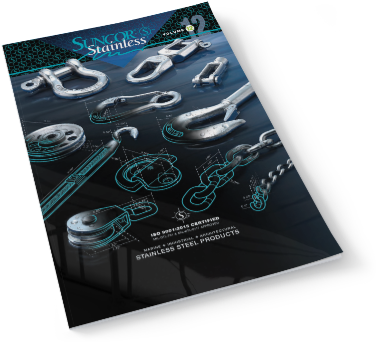Stainless steel is essentially a low carbon steel which contains Chromium at 10% or more by weight. It is this addition of Chromium that gives the steel its unique stainless, corrosion resisting properties.
The Chromium content of the steel allows the formation of a rough, adherent, invisible, corrosion-resisting Chromium Oxide film on the steel surface. If damaged mechanically or chemically, this film is self-healing, providing that Oxygen, even in very small amounts, is present. The corrosion resistance and other useful properties of the steel are enhanced by increased Chromium content and the addition of other elements such as Molybdenum, Nickel and Nitrogen.
There are more than 60 grades of stainless steel. However, the entire group can be divided into five classes. Each is identified by the alloying elements which affect their microstructure and for which each is named.
Why choose stainless steel over other materials?
The many unique values provided by stainless steel make it a powerful candidate in materials selection. Engineers, specifiers and designers often underestimate or overlook these values because of what is viewed as the higher initial cost of stainless steel. However, over the total life of a project, stainless steel is often the best value option. Some of the many benefits of stainless steel can be found below:
- Corrosion resistance
Lower alloyed grades resist corrosion in atmospheric and pure water environments, while high-alloyed grades can resist corrosion in most acids, alkaline solutions, and chlorine bearing environments, properties which are utilized in process plants.
- Strength-to-weight advantage
The work-hardening property of austenitic grades, that results in a significant strengthening of the material from cold-working alone, and the high strength duplex grades, allow reduced material thickness over conventional grades and therefore, cost savings.
- Long-term value
When the total life cycle costs are considered, stainless steel is often the least expensive material option.
- Impact resistance
The austenitic microstructure of the 300 series provides high toughness, from elevated temperatures to far below freezing, making these steels particularly suited to cryogenic applications.
- Fire and heat resistance
Special high Chromium and Nickel-alloyed grades resist scaling and retain strength at high temperatures.
- Stainless Steel is a “Green” material
To ensure a high quality of life, the materials that we use as consumers and manufacturers should meet not only technical performance standards, but have a long service life, be usable in a great number of applications, and be environmentally friendly. Once their service is complete, they should be 100% recyclable, thereby completing the life cycle to be used once again. Stainless steel is such a material.
The longevity of stainless is the result of the alloying composition and, therefore, it has a natural corrosion resistance. Nothing is applied to the surface that could add additional material to the environment. It does not need additional systems to protect the base metal, the metal itself will last.
Stainless steel needs less maintenance and its hygienic qualities means that we do not have to use harsh cleaners to get a clean surface. There is little or nothing to dump into the drain that could have an environmental impact.
Stainless steel products complete their service life. There is less concern about disposal since this material is 100% recyclable. In fact, over 50% of new stainless steel comes from old melted stainless steel scrap, thereby completing the full life cycle.
- Hygiene
The easy cleaning ability of stainless steel makes it the first choice for strict hygiene conditions, such as hospitals, kitchens, abattoirs and other food processing plants.
- Aesthetic appearance
The bright, easily maintained surface of stainless steel provides a modern and attractive appearance.
- Ease of fabrication
Modern steel-making techniques mean that stainless can be cut, welded, formed, machined and fabricated as readily as traditional steels.
